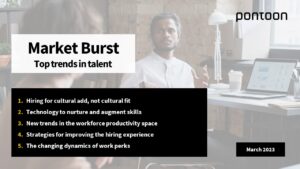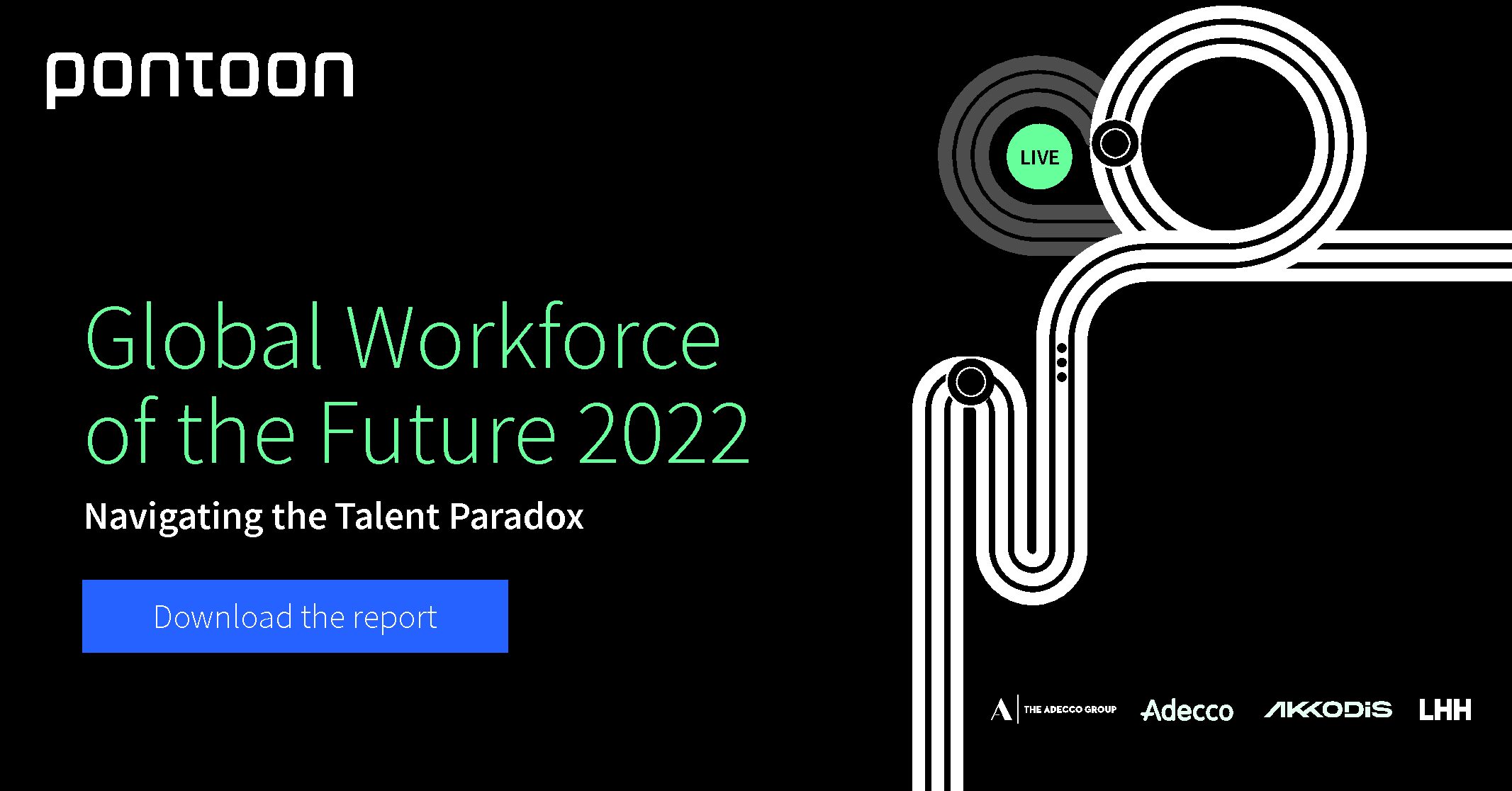Market Burst: March 2023
Read about top trends in the world of work.
In this month’s instalment of our Market Burst, we dive into the trends that continue to drive talent management in the evolving workspace. These include hiring for cultural add, AI nurturing people’s skills, strategies for improving the hiring experience and more.
Hiring for cultural add, not cultural fit
Employing the right workers for open roles is critical to the success of any organisation. To this end, many firms look for candidates who, besides offering essential skills, are also a good fit within organisational culture. While preferring individuals whose beliefs and everyday behaviours perfectly align with corporate values may seem like a good hiring approach, it can be limiting.
The “cultural fit” constraint substantially reduces the available talent pool, which is especially problematic for niche and hard-to-fill roles. Similarly to hiring for specific degrees, rather than skills, recruiting for a perfect culture-match can result in unnecessarily rejecting valuable candidates. In fact, according to a recent Gallup survey, only 20% of workers strongly agree they feel connected to their organisation’s values, meaning 80% of the employed deliver required outputs without being fully attached to their companies’ mission and vision.
Hiring based on cultural fit can lead to unconscious bias. To eliminate that risk, companies should focus on “cultural add”. Research suggests that organisations that intentionally add to their culture – by hiring individuals with unique values, strengths, backgrounds, and perspectives – experience superior performance and engagement levels due to increased diversity of thought in their teams.
When hiring for cultural add, companies should adopt more inclusive approaches and find candidates who can bring something different and unique to the team. This could mean looking beyond traditional job qualifications and focusing more on qualities such as creativity, adaptability, and open-mindedness. Employers should also consider candidates’ background experience, interests, and values when evaluating them for a role. This can be invaluable in creating a work environment where innovation can thrive. It also helps foster a culture of acceptance and respect among employees.
Technology to nurture and augment skills
Artificial intelligence has a massive potential to improve the world of work, including recruitment. Still, like any novel technology, especially one that automates processes, it also generates anxieties around reducing jobs for humans. Meanwhile, a recent survey by McKinsey reveals that real top-line productivity comes when data, technology, and people are fully connected. Companies focusing on getting value from AI and nurturing talent within their business stand to gain a premium of up to 11% on top-line productivity, compared to only 4% for firms that unlock just data and tech. These numbers suggest that technology alone cannot replace humans but can augment their skills and boost their potential.
At Pontoon, we fully support this endeavour. Just recently, our President – Christoph Niebel – and Director of Talent Sourcing – Michael McCarthy – discussed how deploying a sourcing bot improved the hiring process experience for the candidates, the clients, and Pontoon’s recruiters. The bot we use can source more candidates and engage with them 24/7, speeding up the process, increasing efficiency, and boosting demand. Having the tech deployed hasn’t reduced our headcount – on the contrary, it increased the number of our sourcing experts 10x.
Pontoon is an early adopter in the field of automating recruitment processes. We have more stories to share about how we used AI to hire hundreds of tech roles in nine days or how automation lent speed and transparency to our customer’s onboarding process.
New trends in the workforce productivity space
Although 2023 has just started, there’s already plenty of trends driving the workplace, including a few linked to last year’s “quiet quitting”. As major tech companies continue laying off workers, so-called resenteeism takes the stage. It is the act of staying in an unsatisfying job due to a lack of other options or for fear of economic instability. Pontoon’s latest Global Workforce of the Future report revealed that nearly 6 in 10 workers are very concerned about the uncertainty brought on by inflation, recession, and firms reducing staff – 48% of respondents say it will make it much harder to find future jobs. These numbers are in striking contrast with the times of Great Resignation when people were shifting between companies and many employers struggled to attract talent.
The critical thing to remember is that while workers may be more eager to stay, their productivity suffers. According to panellists at the recent World Economic Forum in Davos, this poses long-term risks and reflects a changing relationship between employees and their companies. The experts agreed it’s primarily a top-down leaders’ job to solve current productivity issues. Still, to solve the problem, firms require substantial input from their employees about what works well and what changes they want to see. To this end, exit interviews should be replaced with entry or stay interviews that provide a safe forum for people to reflect on their work experience and share insight into parts of organisation culture that resonate well and those that need improvement. Also, given the differing needs of the generations currently entering the workforce, managers require substantial upskilling on how to engage their people, especially virtually, and what motivates them to stay. With the reports showing that one of the key reasons workers quit is the lack of development opportunities, firms need to invest in internal mobility and career progression programmes, as acquiring new skills and forging new professional paths re-energise employees dissatisfied with their job.
Strategies for improving the hiring experience
Today’s candidates are looking for a streamlined and consistent hiring process that makes them feel respected every step of the way – from job descriptions to onboarding. Meaningful interactions are key; however, a recent study of 1,500 global workers found that while 70% of job seekers want feedback on an interview, nearly 8 in 10 never hear back. With each job opportunity, candidates have high expectations of their potential employer. Anything that detracts from a smooth experience – such as long application forms or lack of timely feedback – can mean saying goodbye for good.
Pontoon’s VP of Global Accounts, David Molina, recently shared some strategies for boosting candidates’ experience in the recruitment process. The critical first step is to prepare hiring managers through training sessions focused on building rapport with candidates and understanding the different types of interviews and their unique purposes. Second, personalised communication can make a big difference in how applicants perceive their overall experience during the hiring process. Taking time to send creative and customised messages throughout each recruitment step makes candidates feel respected as individuals rather than just numbers in a sea of applicants. Third, to avoid job seekers deciding against pursuing a role, recruiters should set clear expectations regarding timelines and share essential information with candidates at each crucial hiring juncture.
It takes time and dedication to discover the right balance between technology and the human touch, which can vary depending on the candidate. That’s why having an experienced recruitment partner to help streamline your recruiting process is so important. Learn more about how Pontoon RPO can support you on this journey.
The changing dynamics of work perks
Firms are scaling back employee benefits amid current economic uncertainty. Some companies are targeting in-office perks, saying these are not crucial for a hybrid workforce and can bring immediate savings. Other firms are cutting benefits as part of their company-wide restructuring and downsizing. For example, the software provider Twilio will scrap wellness allowances and phase out their paid sabbatical scheme, in addition to a 17% workforce reduction. Similarly, Twitter reduced benefits connected with employee wellness, productivity, training, and more, after slashing the firm’s workforce by 50% last year.
While putting the brakes on benefits may seem like a perfect short-term solution for reducing costs, some experts claim that leaders must focus on protecting long-term aspirations and culture in times of economic downturn. According to Gartner’s report, only 43% of organisations achieve the level of savings they set out to in the first year of cost reduction, and just 11% can sustain the cuts over a three-year period. Meanwhile, not investing in work perks, especially related to healthcare, can damage employee experience, engagement, and productivity. Understanding that impact can help avoid rash decisions that could damage key talent outcomes in the long-term.
If cutting benefits is unavoidable, firms should find ways to provide other options for boosting employee engagement. Otherwise, they risk higher turnover and decreased appeal in the job market. Possible alternatives include flexible hours and remote work options to help employees adjust and change their day-to-day routines without sacrificing productivity. Also, employers can offer access to apps that promote physical, mental, and emotional health to show employees that the company values their well-being and is willing to invest in them even during difficult economic times. This investments will help create a better workplace environment and retain top talent.
Related Post
The Global Workforce of the Future Report is our third annual global workforce study that looks at workers’ perspectives on key topics that impact the future of work.
The findings will ...





